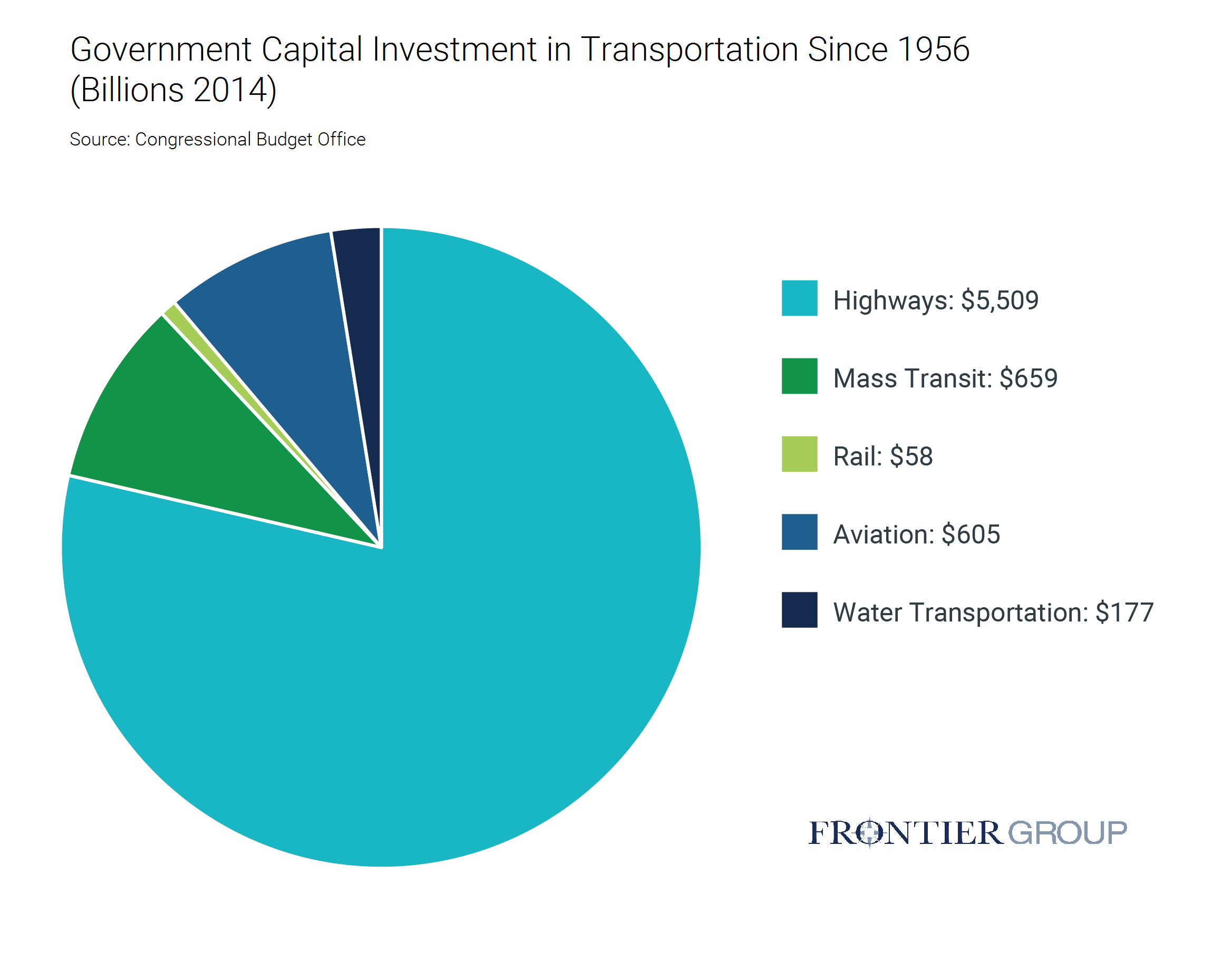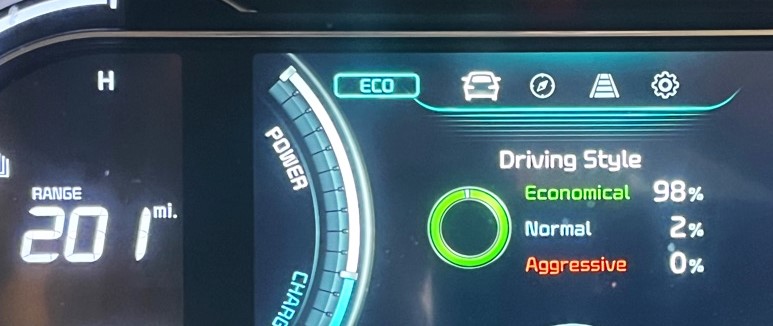
50 Steps Toward Carbon-Free Transportation
America’s transportation system has emerged as Climate Enemy #1, with cars, trucks and other vehicles now representing the nation’s largest source of carbon pollution, and America producing more transportation carbon pollution per capita than any other major industrialized nation. There is hope, however. New technologies and emerging social trends, from the resurgence of interest in walkable neighborhoods to advances in electric vehicles – create new opportunities to move the nation toward a zero-carbon transportation system, and to do it in ways that improve our health and well-being and support a vibrant economy.

In 2016, transportation became the nation’s number one source of the carbon pollution that is warming the planet. With support from the Hewlett Foundation, Frontier Group led a year-long effort to envision pathways and policies to move toward zero-carbon transportation, producing two reports:
• A New Way Forward shows that there are multiple paths to a clean transportation future, available to every American city.
• 50 Steps Toward Carbon-Free Transportation outlines how current U.S. transportation policy sets us back in the fight against global warming and provides a comprehensive, pragmatic agenda for reform.
America and the world must reduce emissions of greenhouse gases immediately and dramatically if we are to prevent the worst impacts of global warming. If the world is to meet the promises of the Paris Climate Agreement, and limit global warming to no more than 2°C, the United States will have to virtually eliminate carbon pollution by mid-century.
America’s transportation system has emerged as Climate Enemy #1, with cars, trucks and other vehicles now representing the nation’s largest source of carbon pollution, and America producing more transportation carbon pollution per capita than any other major industrialized nation.
There is hope, however. New technologies and emerging social trends, from the resurgence of interest in walkable neighborhoods to advances in electric vehicles – create new opportunities to move the nation toward a zero-carbon transportation system, and to do it in ways that improve our health and well-being and support a vibrant economy.
To get there, America must reimagine our transportation policies and empower cities and states to implement effective solutions.
Current federal and state transportation policies in the United States often set us back in the fight against global warming. To move toward a carbon-free transportation system, America must adopt a bold new vision for transportation policy – using 50 common-sense policy reforms helping to chart a new way forward.
America has the tools to move toward a carbon-free transportation system.
America can eliminate carbon pollution from transportation in time to prevent the worst impacts of global warming. The New Transportation Toolbox is rich with promising approaches to cut carbon pollution:
Repowering Vehicles: Efficient electric vehicles that can be powered by clean, renewable electricity are entering the marketplace faster than the hybrid cars of a decade ago and technology continues to improve, removing barriers to electric vehicle adoption.
Urbanization and Smart Growth: American cities, especially their downtowns, are experiencing a renaissance, driven by a growing desire for walkable living.
Shared Mobility: An explosion of technology-enabled services – from carsharing to bikesharing to Lyft and Uber – has begun to revolutionize transportation in many cities. Services such as carsharing have already been shown to reduce vehicle ownership, driving and carbon pollution, and smart public policies can help to ensure that other shared mobility services deliver benefits as well.
Public Transportation: Public transportation reduces vehicle travel (and greenhouse gas emissions) by about 10 percent in U.S. cities, and cities across the country are considering bold plans to expand access to high-quality transit.
Reallocating Space: Cities in the United States and around the world are reallocating space formerly devoted to cars to other public purposes, helping to fuel increased use of low-carbon modes of transportation.
Smart Pricing: Americans typically pay nothing to drive on most roads and enjoy the lowest gas taxes in the industrialized world, encouraging excessive driving and congestion. Cities around the world have shown that smart pricing policies can reduce congestion and encourage the use of low-carbon modes of travel.
Walking and Biking: Americans prefer walking to any other mode of transportation, according to a recent survey, and the number of people traveling by bicycle in many cities has grown dramatically in the last decade.
Information Technology: Advances in technology are enabling Americans to plan, schedule and pay for trips via low-carbon modes as easily as traveling by car.
In addition, autonomous vehicles can be deployed in ways that can support efforts to reduce greenhouse gas emissions – especially if they facilitate the use of shared mobility services, vehicle electrification and smart pricing, and if public policy limits any increases in vehicle travel resulting from automation.
A series of common-sense policy principles can guide America toward a zero-carbon transportation system. Current state and federal policies, however, fall far short of those principles.
Principle 1: Climate concerns should inform every transportation policy decision.
America cannot expect to make climate-smart transportation infrastructure and policy decisions without setting goals for reducing carbon pollution from transportation, evaluating progress toward those goals, prioritizing policies and projects that benefit the climate, and creating mechanisms for holding government accountable for progress.
The Reality:
- Climate change is rarely a factor in transportation decision-making. Only seven states have enforceable, economy-wide limits on carbon pollution, and, as of 2012, the vast majority of states and metropolitan planning organizations did not even consider greenhouse gas emissions in agency planning processes. States regularly make policy decisions – such as increasing highway speed limits – with little to no consideration of greenhouse gas impacts.
- Until recently, the federal government did not require that transportation projects be evaluated for their impacts on the climate. In 2016, the Obama administration moved to require states to include climate assessments in environmental reviews for federally funded transportation projects, and proposed that states adopt non-binding performance targets for transportation greenhouse gas emissions and track progress toward those targets.
Principle 2: Low-carbon transportation should be at the front of the line for public funding.
If the nation is to reduce carbon pollution from our transportation system, we need to invest accordingly.
The reality:
- America spends vastly more on infrastructure for high-carbon modes of travel than low-carbon modes. Between 1956 and 2014, 79 percent of all government capital expenditures on transportation went toward highways, according to Congressional Budget Office data. Since 1995, subsidies for highways from general tax revenues have increased faster than subsidies for public transportation.
- Bureaucratic hurdles hamper low-carbon transportation investment. The federal funding match for new highway projects is generally higher, and the burden of evaluation lower, than major transit capital projects. Many state governments are barred from using gas tax revenues for purposes other than roads and bridges, with 24 states, home to more than 113 million people, spending the equivalent of less than a penny per person per day in state funds on public transportation.
- Low-cost strategies to improve transportation efficiency – such as transportation demand management programs and intelligent transportation systems – receive scant funding or attention.
Figure ES-1. Government Capital Investment in Transportation Since 1956

Principle 3: People should be rewarded for making low-carbon transportation choices.
Americans will choose low-carbon transportation when it is more convenient, more comfortable and cheaper than high-carbon alternatives. Tax policies and market structure should reward decisions to use low-carbon modes of travel.
The reality:
- The tax code provides direct and indirect incentives that encourage driving. In most states, motor fuels are exempt from general state sales taxes, while the income tax exclusion for commuter parking subsidizes rush hour driving to the tune of more than $7 billion per year.
- U.S. gasoline taxes fail to compensate society even for the cost of maintaining and building highways, let alone impacts such as pollution, congestion and noise that driving inflicts on society. Incorporating such costs in the cost of gasoline would increase its cost by roughly $2.10 a gallon, according to researchers with Resources for the Future.
- Tax policies often limit the growth of innovative travel models. Carsharing faces excessive taxation in many cities, while bikesharing and other shared mobility modes are excluded from pre-tax commuter benefits programs.
Principle 4: Carbon-intensive vehicles and fuels should be phased out.
A transition to vehicles capable of running on zero-carbon sources of energy – such as electric vehicles – is a prerequisite for eliminating carbon pollution from transportation by mid-century.
The reality:
- The Obama administration has made a commitment to reducing greenhouse gas emissions from cars and trucks through the adoption of landmark vehicle fuel economy and greenhouse gas emission standards. But current standards do not take full advantage of recent technological advances in energy efficiency and zero-emission vehicles to maximize reductions in carbon pollution.
- Federal policies have failed to tap the potential of lower-carbon fuels, with the federal Renewable Fuels Standard currently serving largely to encourage the use of corn ethanol, which has little to no greenhouse gas emissions benefit relative to gasoline.
Principle 5: Public policy should encourage climate-friendly communities.
Communities that are designed in ways that allow walking, biking, transit and shared mobility to serve as viable daily options create many opportunities for low- or zero-carbon transportation. Public policies – including policies at the federal and state level – can help support the creation of those communities.
The reality:
- Public policies often hamstring the creation of climate-friendly communities. Federal housing and state economic development subsidies often privilege single-family housing, discourage mixed-use development, and support the migration of businesses and jobs from city centers to auto-centric suburbs.
- Many state and local governments retain policies that make the development of climate-friendly communities more difficult or impossible. Some states have shown the way forward by adopting policies to encourage compact forms of development or to lift barriers to new housing construction in high-demand markets, while some localities have begun to lift mandatory minimum parking requirements that add to the cost of new housing development and consume precious and limited urban space.
Principle 6: Public policy should foster innovation.
The past decade has brought tremendous innovation in information technology, shared mobility, and vehicle automation – much of it driven by private investment. By fostering and shaping innovation in ways that maximize potential climate benefits, cities and states can help lay the groundwork for a future transportation system that reduces carbon pollution.
The reality:
- Key state and federal policies hamper innovation by failing to account for changing circumstances such as the emergence of shared mobility services or growing demand for urban living, or by locking officials into spending or policy practices more attuned to the needs of a previous generation.
- Recent years have seen state legislatures exercise veto power over local decisions to adopt low-carbon transportation technologies, while existing modal “silos” in state and federal transportation agencies limit agencies’ ability to prioritize transportation projects that can reduce emissions.
- The quality and volume of transportation data collected by federal and state agencies is often poor, while transportation agencies have failed to make effective use of “big data” sources or streams of privately gathered data that can improve transportation planning and operation.
Federal and state governments should set goals for reducing carbon pollution from transportation consistent with the goals of the Paris Climate Agreement, and align transportation policies with the goal of eliminating carbon pollution from transportation by mid-century.
Specifically, state and federal governments should consider a series of 50 policy reforms that can help to pave the way for a zero-carbon transportation system. Specifically, policy-makers should:
- Make addressing global warming a strategic goal by setting and enforcing targets for greenhouse gas emission reductions from transportation and incorporating accurate assessments of climate impacts into every facet of transportation decision-making – from decisions on specific projects to the development of long-term transportation plans.
- Stop doing harm, by shifting public and private investment away from infrastructure that encourages carbon-intensive forms of travel and land use and toward low-carbon modes of travel.
- Reform the transportation bureaucracy and policy framework by revising criteria for allocating transportation funds; ensuring that state policies promote the use of low-carbon modes of travel; eliminating counterproductive “level of service” criteria from environmental and land-use reviews; and breaking up modal silos to allow for better transportation decision-making.
- Get the most out of what we have by maximizing the efficient use of existing infrastructure. States should be permitted and incentivized to use road pricing as a tool to reduce emissions and curb congestion, while transit agencies should be allowed to spend federal financial assistance to sustain or expand operations. Transportation demand management, intelligent transportation services, “complete streets” and active transportation strategies, and other “infrastructure-light” solutions should take center stage in addressing transportation challenges.
- Level the playing field for shared mobility by eliminating excessive taxation for carsharing; ensuring that shared mobility services with a positive impact on the climate are treated equitably in commuter benefits programs; and encouraging the substitution of shared mobility packages for mandated parking in new developments.
- Harness the power of markets by implementing carbon pricing, road pricing, distance-based insurance, and demand-responsive parking pricing where appropriate, and by considering new models of transportation service delivery and governance.
- Speed the introduction of low-carbon vehicles by strengthening and enforcing strong fuel economy and greenhouse gas emission standards, as well as state zero-emission vehicle standards; by continuing tax and other incentives for clean vehicles; and by taking advantage of synergies between efforts to clean up transportation and efforts to clean up the electric grid.
- Speed the introduction of low-carbon fuels by supporting a transition from fuel-specific mandates to a fuel-neutral low-carbon fuel standard, and by encouraging a broader transition to renewable energy.
- Align transportation and land-use objectives by targeting federal and state housing and economic subsidies to support low-carbon growth patterns; integrating land-use criteria into transportation project selection; removing state and local barriers to the creation of new housing in walkable, urban areas; and allowing transportation funds to be used to support transit-oriented development.
- Support and guide innovation by revising transportation policies and plans and the models that shape transportation decision-making; enabling and encouraging local innovation; adopting policies that maximize the sustainability benefits of new technologies; and supporting research and development into innovative, low-carbon transportation strategies.
- Expand access to new mobility solutions by ensuring that shared mobility services are available to all and encouraging early use of electric and other vehicles with the potential to provide emission-free travel in a wide range of communities.
- Collect and share data by devising and enforcing common standards for data collection and provision by public and private service providers; maximizing the provision of open data; enhancing data analysis capabilities; and protecting consumer privacy.
- Reevaluate transportation governance to ensure that America has institutions with the capability to envision strategies to move the nation toward zero-carbon transportation and empower people and businesses to make it happen.
Topics
Authors
Tony Dutzik
Associate Director and Senior Policy Analyst, Frontier Group
Tony Dutzik is associate director and senior policy analyst with Frontier Group. His research and ideas on climate, energy and transportation policy have helped shape public policy debates across the U.S., and have earned coverage in media outlets from the New York Times to National Public Radio. A former journalist, Tony lives and works in Boston.
Find Out More

Five key takeaways from the 5th National Climate Assessment

Carbon dioxide removal: The right thing at the wrong time?

Fact file: Computing is using more energy than ever.

